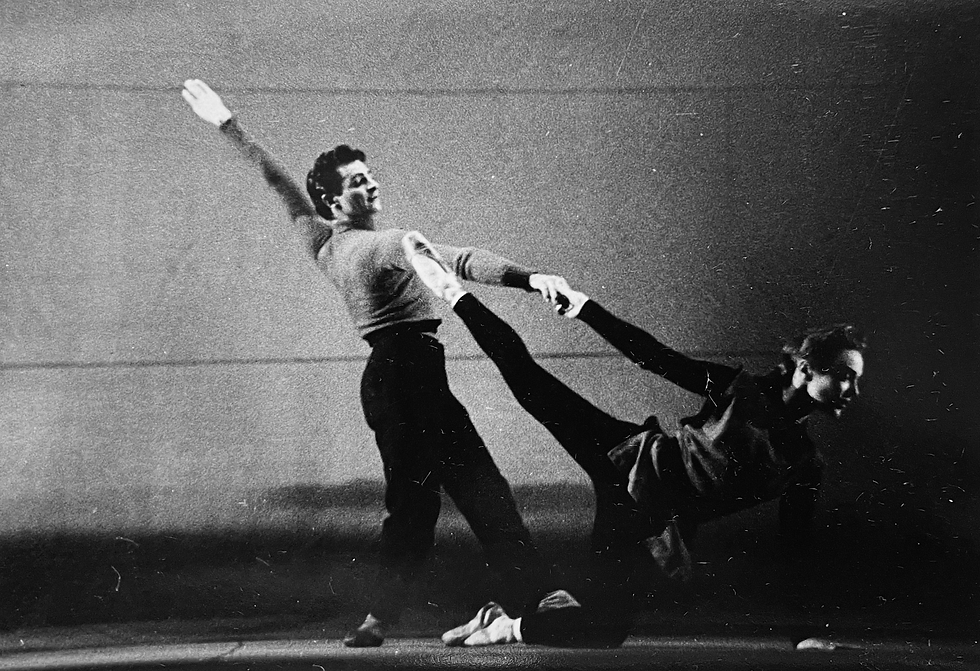NYCB Vol. 11 No. 17 - Interplay
- Lauryn Johnson

- May 9, 2024
- 3 min read

Edwin Denby wrote:“Robbins’ Interplay, once in Billy Rose's"Concert Varieties" and now a success in Ballet Theater's repertory, is of serious interest both for being young Robbins's second work and for being, of all the ballets by American-trained choreographers, the most expertly streamlined in dance design. "Interplay" looks like a brief entertainment, a little athletic fun, now and then cute, but consistently clear, simple and lively. You see four boys come out and then four girls and all eight join in improvised games (such as follow-the-leader) done in dance terms; there is a boy's joking show-off solo, and a duet with : touch of blues sentiment in the air, and then all eight together play another game, competing in leaps and spins with the effect of a collective speed-up finale. It looks rather like an American outdoor party where every one is full of pep and naively rough and where the general unfocussed physical well being is the fun of the occasion. Still, watching how the dancers behave to each other, it isn't always clear if they represent twenty-year-olds being cute or maybe children on their good behavior.

“But leaving aside the subject matter (which the program doesn't clarify either) what immediately captures. your attention is the pace of the piece, the clear drive of its dance impetus, and the athletic verve of the cast a perfect cast in which Harold Lang is especially brilliant.
The physical spring of the athletic phrases obviously suits the dancers and the impetus of the movement obviously suits that of the score as well; and the whole continuity is perfectly clear to the eye as dance architecture. There is nothing subtle about the dance-nor about the score, Gould's "Concertette," for that matter; the texture and the expressive accents are commonplace; but nowhere does this piece break down and becomes fragmentary, fussy or thick.

“And this is a serious achievement. Robbins alone of our native choreographers has grasped at one stroke b that the basis of ballet logic is at view of time and space as a closed entity. The time of a ballet is that specified by the musical architecture of its score and the space is that of the stage area as a static whole. These architectural frames of reference, so to speak, give to the mazes of a ballet its coherent and cumulative distinctness. And the formal distinctness in spacing and timing Interplay has in action are of serious ballet quality.
“Not of serious ballet quality is Interplay's specific dance technique. Robbins does not have the resource of deploying the body un-self-consciously, of a sustained and natural soaring and sailing; the foot positions are only approximate and this spoils the buoyancy and sharpness of floor contact and of phrase construction; he tries for vivacity by again and again overspeeding pirouettes; his jokes are sometimes too coy; he does not distinguish between the timing of pantomime and of dance gesture; and the accents of the dance are likely to be energetic thrusts expressing a shot-in-the-arm vigor rather than an individual response to a dramatic moment. But perhaps Robbins feels that both the score and the subject matter of Interplay call for a general vigor rather than for a modulated and individual grace.

“The characters of Interplay seem to be urban middle class young people having a good time, who know each other well and like being together but have no particular personal emotions about each other and no special keenness of response. They know about sex as a live joke or as a general blues sentiment; they don't know lit as an individual focus of pas-sion. From a hint of personal sincerity they turn untroubled and vague with a coltish playfulness, expert in strength but blunt in edge. In this unpersonal aspect of Interplay, there might be the poetic subject matter of an American flavor of sentiment. And Robbins has, I think, a poetic love for the air of rudeness and unresponsiveness in our national manners. But in Interplay he has glossed it over by a general mutual amiability that is humanly unconvincing and a bit goody-goody; he has for the moment confused love of America with flattery. Such criticism is nonsense if Interplay is taken as passing entertainment; but not if it is taken as some sort of serious ballet. And the intellectual vigor the clear focus of its over-all craftsmanship suggests--as Fancy Free suggested in another way that Robbins means to be and can be more than a sure-fire Broadway entertainer, that he can be a serious American ballet choreographer.”
--Edwin Denby, New York Herald Tribune, November 4, 1945




Comments